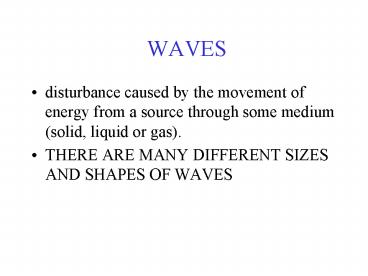WAVES - PowerPoint PPT Presentation
1 / 59
Title:
WAVES
Description:
Tsunamis long wavelength, shallow water progressive waves caused by rapid ... Tsunami. A tsunami can be a wave w/ a wavelength up to 125 miles! ... – PowerPoint PPT presentation
Number of Views:89
Avg rating:3.0/5.0
Title: WAVES
1
WAVES
- disturbance caused by the movement of energy from
a source through some medium (solid, liquid or
gas). - THERE ARE MANY DIFFERENT SIZES AND SHAPES OF WAVES
2
Global Wave Height
Fig 9-10, p.181
3
WAVES
- The energy is moving at the speed of the wave,
but NOT the water
4
Fig 9-1, p.174
5
WAVES
- The parcel of water moves in a circular motion
orbit - water is displaced very little across the sea
surface as the illusion of a wave suggests
6
Fig 9-2, p.175
7
Fig 9-3, p.175
8
WAVES
- Because the wave form moves forward these are
called progressive waves
9
Wind wave ratio of height to wavelength (wave
steepness) 1 to 7
Fig 9-11, p.181
10
Fig 9-12, p.182
11
Components
- Crest
- Trough
- Wavelength
- Height
- Frequency
- Fetch
- Wavebreak
- refraction
12
Fig 9-2, p.175
13
Wave fetch uninterrupted distance over which
the wind blows w/o significant change in
direction.
Fig 9-9, p.180
14
Wavebreak ratio of wave height to water depth
is 3 to 4
Fig 9-15, p.183
15
fnft
16
Fnft
17
Wave refraction
Fnft
18
Wave crests bend 90 degrees as they move around
point (Hawaii) refraction
Fig 9-17, pg. 185
19
Fig. 9-17a, p. 185
20
types of waves
- Shallow water wave
- Deep water wave
- swell (capillary wave)
21
Deep water wave
Shallow water wave
Fnft
22
Orbits
- The diameter of the orbits diminishes rapidly
with depth - Wave motion in deep water is negligible past ½
the wavelength
23
Fnft
24
Stokes Drift or Mass Transport
- Small net movement of water in the direction of
the wave
25
Figure not from book
26
Classifying Waves
- disturbing force the energy that cause waves to
form - restoring force the dominant force trying to
return surface water to flatness - wavelength
27
Wave energy as a function of wave period
Fig 9-4, p.177
28
Wave Types
- Capillary waves
- Wind
- Surface tension
29
Capillary waves interrupt the smooth surface,
deflect upward, Slow cause winds energy to be
transferred into the water. A crest Btrough
Fig 9-7, p.179
30
Swell mature, regular, wind waves
Fig 9-8, p.165
31
fnfb
32
Deep vs Shallow Water waves
- The orbits of water molecules in a wave are
circular only when the wave is in deep water - A wave cannot feel the bottom if it is in water
deeper than ½ its wavelength - a deep water wave
33
fnfb
34
Deep vs Shallow Water Waves
- Shallow water waves moving in water shallower
than 1/20 it wavelength - Water at the bottom moves back and forth
35
fnfb
36
Deep vs Shallow Water Waves
- Transitional waves travel through water deeper
than 1/20 their wavelength and shallower than ½
its wavelength
37
fnfb
38
Deep vs Shallow Water Waves
- ONLY WIND WAVES CAN BE DEEP WATER WAVES
39
Fig. 9-5, p. 177
40
How waves break at shore...
- A deep water waves feels bottom and becomes a
transitional wave - orbits become elliptical
- crests become peaked
- wave height increases
- wave slows down
- wave length decrease
41
Wavebreak ratio of wave height to water depth
is 3 to 4
Fig 9-15, p.183
42
fnft
43
How waves break at shore...
- The wave becomes too high for its wavelength and
the wave breaks - The surf zone is the region between the breaking
waves and the shore.
44
INTERFERENCE
- Destructive interference cancellation effects
of subtraction - When a wave crest and another waves trough
coincide
45
INTERFERENCE
- Constructive interference addition effects that
form large crests and deep troughs - When crests coincide
46
Fig 9-14, p.182
47
Wave Refraction
- When waves do not approach parallel to shore
- The wave line will bend to become more parallel
to shore
48
Wave refraction
Fnft
49
Wave crests bend 90 degrees as they move around
point (Hawaii) refraction
Fig 9-18b, p.185
50
Types of Waves
- Tsunamis
- Seismic Sea Waves
51
Types of Waves
- Tsunamis long wavelength, shallow water
progressive waves caused by rapid displacement of
ocean water. This is caused by sudden vertical
movement of earth along a fault line, causing a
Seismic Sea Wave. - Origination on seafloor, a problem for
continental populations if this is close to land
or in a confined space!
52
Tsunami
- A tsunami can be a wave w/ a wavelength up to 125
miles! - Remember the deepest ocean basin is 7() miles
deepif a wave ½ wavelength its still not
enough room to move (do the math!) - Problem a tsunami wave can reach a height of
over 100
53
Fig 9-27, pg. 192
54
1946 Hawaiian tsunami
Fig 9-21, p.188
55
5 hrs. earlier earthquake
Sequence 1957 Hawaii tsunami
Fnft
56
15 minutes later
Fnft
57
2 hrs. total duration 56 total wave height,
25 million in damages
Fnft
58
Fig. 9-CO, p. 172
59
Fig 9-26, p.191































